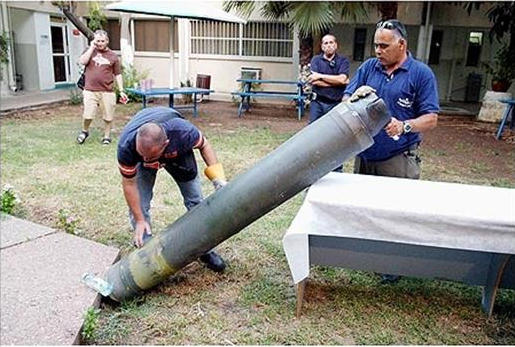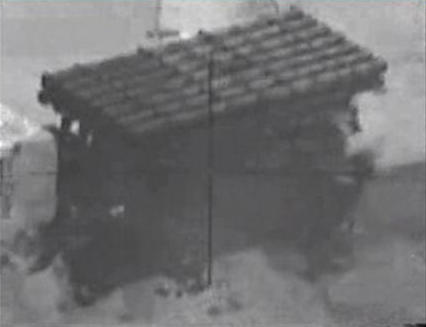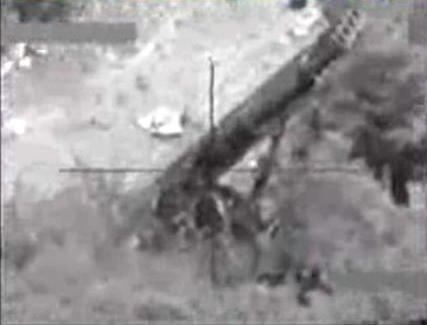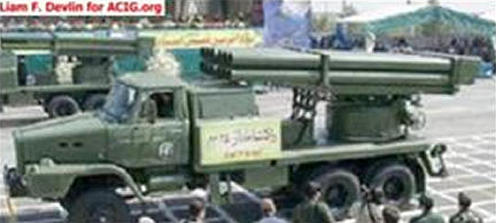Vol. 6, No. 10 August 31, 2006
-
From July 13 to August 13, the Israel Police reported 4,228 rocket impacts inside Israel from rockets fired by Hizballah. No geographical area in the world has sustained such a large quantity of rocket strikes since the Iran-Iraq war in the early 1980s.
-
Most rockets fired by Hizballah at Israel were taken from the Syrian arsenal rather than from Iran. On most occasions, the rocket warhead contained anti-personnel munitions, a mixture of explosives and steel balls or fragments that were lethal to all those caught outside.
-
One-fourth of the rockets that landed within Israel landed within built-up areas. During the first two weeks, rocket attacks averaged about 100 per day. Then in early August, Hizballah proceeded to double its rate of fire to a daily average of 200 rocket attacks. There was a decline during the final week, but on August 13, the day before the cease-fire, 250 rockets landed in Israel. Israeli counterattacks apparently had no serious influence on Hizballah’s rate of fire, but had an effect on the accuracy and geography of the attacks.
-
Israel’s losses and damage from Hizballah rocket attacks include 53 fatalities, 250 severely wounded, and 2,000 lightly wounded. There was extensive damage to hundreds of dwellings, several public utilities, and dozens of industrial plants. One million Israelis lived near or in shelters or security rooms, with some 250,000 civilians evacuating the north and relocating to other areas of the country.
-
Early Warning sirens provided timely alarms, saving innumerable lives. Israel’s long-standing policy of constructing public shelters, combined with building codes that require reinforced spaces in private dwellings, proved to be generally effective as a system of passive defense against most of the rockets fired by Hizballah. Nearly 80 percent of fatalities involved persons caught in the open.
-
Rockets and rocket launchers emerged as one of the defining weapons of the second Lebanon War and will remain so in the foreseeable future. This impacts on the security of U.S. and Western interests in the Middle East. Effective response measures must be devised and deployed as soon as possible. Two objectives should be pursued: first, to reduce the “Flash to Bang” (Hizballah rocket launch to Israeli response) cycle time to a few seconds from the time of launcher location pinpointing; and second, to develop and deploy effective and affordable active defense against rockets to protect vital civilian and military installations.
On July 12, 2006, Hizballah crossed the Israeli-Lebanese border in an ambush, killing three Israeli soldiers and kidnapping two wounded soldiers. Five more Israeli soldiers were killed after the army entered Lebanon in pursuit. The following morning (July 13), Hizballah fired a Katyusha rocket from Lebanon that landed on the main street in the Israeli resort city of Nahariya, killing one woman and injuring at least ten people.
From July 13 to August 13, the Israel Police reported 4,228 rocket1 impacts inside Israel from rockets fired by Hizballah. No geographical area in the world has sustained such a large quantity of rocket strikes since the Iran-Iraq war in the early 1980s. The rocket attacks on northern Israel were anticipated and were factored in to the decision to respond in force to Hizballah’s July 12 attack.
Map of Rocket Strikes on Northern Israel

Most of Hizballah’s Rockets Came from Syria
The great majority of rockets fired at Israel came from Syria. They included:
- Grad-type 122mm Katyusha, range 30 km., warhead 30 kg.
- Improved Grad 122mm Katyusha, range 50 km., warhead 30 kg.
- “220mm rocket,” range 70 km (probably Syrian-manufactured Russian “Ouragan” Multiple Launch Rocket System [MLRS])
- “B302” 302mm rocket, range 100 km, warhead 175 kg. (probably Syrian-manufactured Chinese WS-1 MLRS).





The head of IDF Military Intelligence, Maj.-Gen. Amos Yadlin, told the Knesset Foreign Affairs and Defense Committee on August 24 that with the exception of the long-range Iranian Zelzal missiles, most rockets fired by Hizballah at Israel were taken from the Syrian arsenal rather than from Iran.2 However, debris from an Iranian-made 240mm Fajr 3 with a range of 45 km has also been identified. IDF Chief of Staff Dan Halutz told the Knesset Foreign Affairs and Defense Committee on August 16 that Israel was “successful in destroying 90 percent of [Hizballah’s] long-range rockets.”3


On most occasions, the rocket warhead contained anti-personnel munitions, a mixture of explosives and steel balls or fragments that were lethal to all those caught outside. Out of the 53 people killed in Israel by Hizballah rockets, 41 were outside when the attack occurred.
Impact of a 220mm Anti-Personnel Rocket – Exhibit A

Impact of a 220mm Anti-Personnel Rocket – Exhibit B

Impact of a 220mm Anti-Personnel Rocket – Exhibit C

Impact of a 220mm Anti-Personnel Rocket – Exhibit D

Impact of a 220mm Anti-Personnel Rocket – Exhibit E

Hizballah also attacked Israeli naval vessels with the “Noor” (C802) anti-ship missile that killed four Israeli sailors aboard the Israeli Navy Ship INS Hanit on July 14. In addition, Israel Radio reported that at least one of the Hizballah UAVs downed by the Israeli Air Force carried a 30-kg. bomb. This was the first recorded use of UAVs as land attack cruise missiles.

The Effects of Hizballah’s Weapons
Of the more than four thousand rockets that landed within Israel, three-quarters landed in open areas, but one-fourth (972 – 23 percent) landed within built-up areas. The number of longer-range rockets (50+ km.) fired at Israel was approximately 250.
Patterns of fire could be discerned during the course of the war. From July 13 to August 1, rocket attacks averaged about 100 per day, with a daily fluctuation from 33 to 145. Then Hizballah proceeded to double its rate of fire. From August 1 to August 7, there was a daily average of 200 rocket attacks, with a range of 160 to 215. Between August 7 and August 13 there was a decline, with the highest daily figure reaching 160. However, on the final day before the cease-fire (August 13), 250 rockets landed in Israel. At one point during the war, Hizballah achieved a rate of fire of approximately 150 rockets per hour. Overall, Israeli counterattacks, while affecting accuracy and deflecting fire from Haifa during the last phases of the war, apparently had no serious influence on Hizballah’s rate of fire.
It was also noted that Hizballah had changed tactics in August, concentrating more rockets at the same target, and repeating attacks on points it had just attacked, as those in the shelters began to emerge after what they believed was a safe interval.
Israel’s losses and damage suffered from Hizballah rocket attacks include 53 fatalities, 250 severely wounded, and approximately 2,000 lightly wounded. There was extensive damage to hundreds of dwellings, several public utilities, and dozens of industrial plants. Some 500 forest and brush fires were caused by rocket impacts. One million Israelis had to stay near or in shelters or security rooms, with some 250,000 civilians evacuating the north and relocating to other areas of the country. Most economic activity in northern Israel was suspended for a month.
Impact of Hizballah Rocket on Israeli Apartment

Israeli Response Measures
Early Warning sirens provided timely alarms, saving innumerable lives. Israel’s long-standing policy of constructing public shelters, combined with building codes that require reinforced spaces in private dwellings, proved to be generally effective as a system of passive defense against most of the rockets fired by Hizballah. Nearly 80 percent of fatalities involved persons caught in the open.
In terms of active defense measures, most rockets were detected and tracked by early warning means which presumably provided launch point locations. Counter fire by conventional artillery was marginally effective, as were raids by special forces units on rocket launchers and command posts. Attacks on launchers by air power were moderately effective inasmuch as they degraded the accuracy of the rocket launchers and pushed them out of the optimal launching zones against Haifa. Thus, downtown Haifa was not hit during the later phase of the conflict, except during the last day (August 13) when Hizballah staged an extra effort for this purpose.
Conclusions and Recommendations
Rockets and rocket launchers emerged as one of the defining weapons of the second Lebanon War and will remain so in the foreseeable future. It stands to reason that this will impact throughout the Middle East and encourage radical movements to adopt rocket attacks against U.S. and Western forces and assets. Effective response measures must be devised and deployed as soon as possible.
Rockets and launchers are complex targets: there is no silver bullet to do the job, rather, a “tool kit” approach is needed, offering an array of interconnected solutions. The top priority to ensure Israel’s security is to:
- Reduce the “Flash to Bang” (Hizballah rocket launch to Israeli response) cycle time to a few seconds from the time of launcher location pinpointing.
- Develop and deploy effective and affordable active defense against rockets to protect vital civilian and military installations.
* * *
Notes
1. A note about terminology – a “missile” has a guidance system that can modify its course; a “rocket” has no such guidance system.
2. https://www.haaretz.com/hasen/spages/754563.html
3. https://www.haaretz.com/hasen/spages/751340.html
* * *
Uzi Rubin has been involved in Israeli military research, development, and engineering programs for almost forty years. Between 1991 and 1999 he served as head of Israel’s Missile Defense Organization, and in that capacity he oversaw the development of Israel’s Arrow anti-missile defense system. He was awarded the Israel Defense Prize in 1996. He is the author of “The Global Range of Iran’s Ballistic Missile Program,” Jerusalem Issue Brief 5-26 (June 20, 2006).











